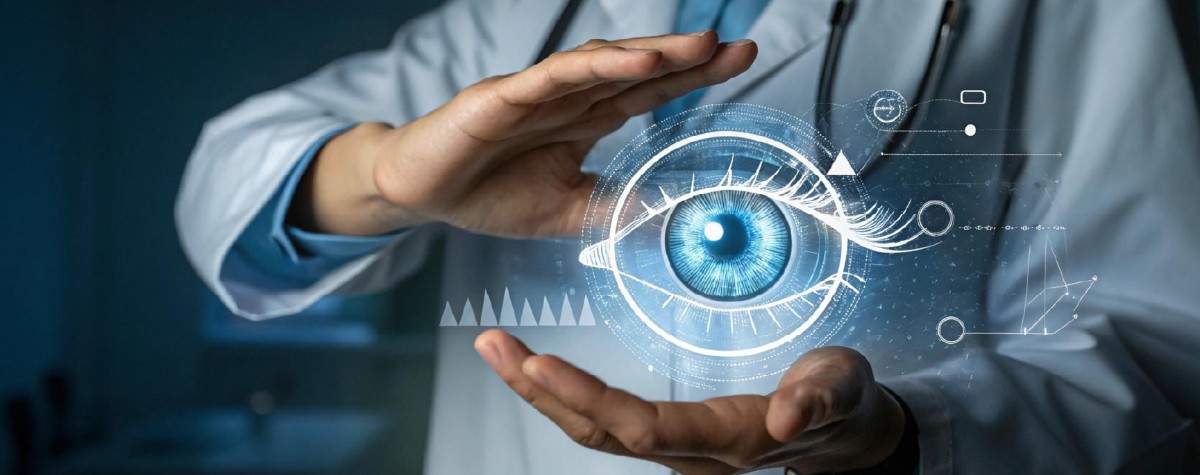


Learn how predictive analytics in eyecare help clinics anticipate patient needs, optimize resources, & deliver superior outcomes with Dash Technologies.
With over 2.2 billion individuals affected globally by vision-threatening conditions, AI in eyecare solutions is essential in overcoming diagnostic accuracy, accessibility, & efficiency challenges in the world of ophthalmology.
Automated retinal screenings detecting diabetic retinopathy with great precision? Predictive algorithms that can estimate patient risk years in advance? AI is revolutionizing the way we think about and treat eye conditions. It’s not just about improving patient care and outcomes, but also about transforming healthcare systems and making specialized eye care more accessible, more efficient, and more affordable.
Eye diseases are a global public health issue, and illnesses such as diabetic retinopathy, glaucoma, & age-related macular degeneration led to permanent vision loss when undiagnosed on time. Conventional diagnosis methods are generally manual review of intricate imaging information, which is a bottleneck in healthcare provision and restricts access to expert services, especially in underprivileged areas.
Arguably, the most significant application of AI in eyecare is in clinical diagnostic applications, which utilize AI to identify eye disease and conditions from medical images or patient data. Standard ophthalmic diagnosis involves expert review of retinal scans, OCT images, visual fields, etc. Ophthalmic AI diagnostics can augment this by reading images quickly and accurately, recognizing subtle patterns that a human may overlook. The outcome is earlier disease detection, and this is vital in the prevention of blindness.
Diabetic retinopathy screening is one of the first use cases where AI in eyecare has been adopted at scale. In 2018, IDx-DR became the first autonomous AI diagnostic system that the FDA approved. In clinical trials, IDx-DR achieved over 96% sensitivity by analyzing fundus photography. Another platform, EyeArt AI, has achieved over 90% accuracy in multiple populations.
These ophthalmic AI diagnostics excel at detecting microaneurysms, hemorrhages, & exudates. This means fewer missed cases, especially in underserved areas where specialists are very scarce. For instance, in a double-blinded study involving over 2,000 images, the AI system Adven-i not only flagged referable cases but also segregated DR from other abnormalities, outperforming many manual screenings.
AMD impacts more than 196 million individuals worldwide and is one of the main causes of blindness among older people. Ophthalmic AI diagnosis relies on deep learning algorithms to read OCT scans, differentiating healthy retinal anatomy from pathological alterations with high accuracy.
The Moorfields-DeepMind collaboration developed AI algorithms that diagnosed multiple retinal diseases from OCT scans with precision many times higher than that of human experts. AI-powered eyecare solutions classify AMD stages from early drusen formation to late geographic atrophy, enabling interventions at the right time to preserve vision.
Glaucoma, the “silent thief of sight,” presents unique diagnostic challenges due to asymptomatic early stages. AI algorithms analyzing OCT images and visual field tests demonstrate exceptional capability in detecting glaucomatous changes and predicting disease progression.
Modern AI systems identify structural abnormalities in the optic nerve head and retinal nerve fiber layer with sensitivity and specificity exceeding 95%. Predictive analytics in eyecare can forecast visual field progression from baseline measurements, enabling proactive treatment adjustments before irreversible damage occurs (more on predictive analytics in eyecare in the next section).
Predictive analytics in eyecare is a step toward moving the industry from being reactive to proactive. These systems process data sets such as patient demographics, genomics, lifestyle habits, and longitudinal imaging data, and use machine learning models to predict the onset of a disease accurately.
AI models are able to predict if a patient will develop diabetic retinopathy up to five years before the disease actually develops, by analyzing retinal vascular networks and changes that the human eye cannot see. For myopia prediction models, the system can predict a child’s refractive changes up to 8 years before they happen, enabling early intervention to prevent high myopia complications.
Predictive analytics in eyecare does not stop at diagnosis but goes on to the optimization of treatment. Machine learning algorithms comparing patterns of patient response to anti-VEGF injections for AMD can forecast treatment frequency needs, optimizing for efficacy and reducing costs. These personalized approaches achieve 30% gains in visual acuity over standard protocols.
